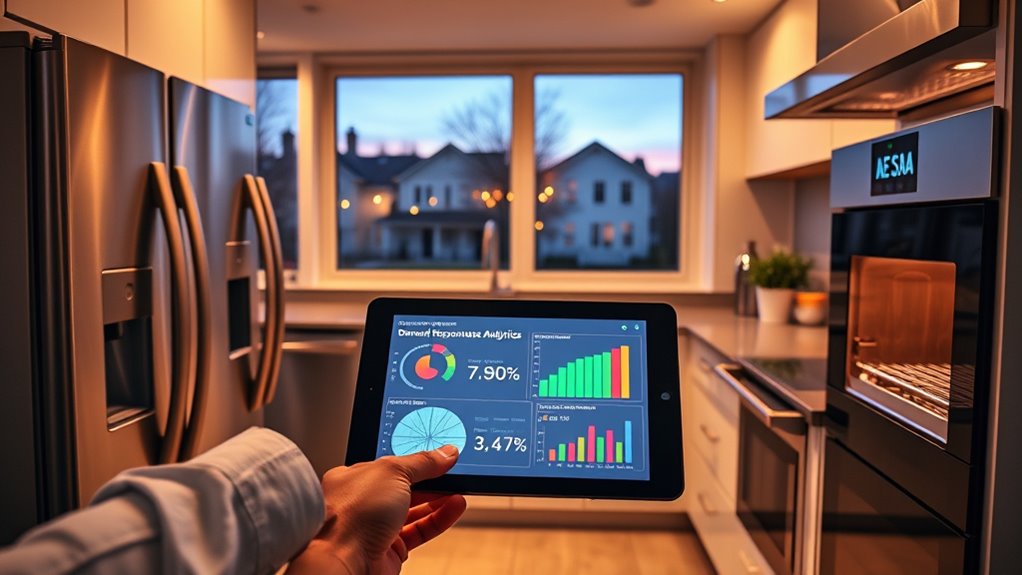Demand-response programs for appliances use economic incentives and market signals to encourage you to adjust energy use during peak times. When prices spike, you might shift or reduce usage, which helps lower costs and supports grid stability. Market structures, such as smart tariffs and rebates, motivate participation, while behavioral factors influence how willingly you adapt. Understanding these economic principles can reveal how policies and innovations aim to make your energy use more efficient—more details await you.
Key Takeaways
- Demand-response programs incentivize consumers to shift appliance use during peak periods, reducing energy costs and balancing supply-demand dynamics.
- Incentive structures like rebates and time-of-use pricing motivate appliance load adjustments, enhancing program economic efficiency.
- Consumer participation depends on perceived cost savings, behavioral habits, and ease of use of automated or smart appliances.
- Market competition and transparent pricing signals incentivize appliance manufacturers to develop energy-responsive products.
- Cost-benefit analyses weigh program implementation costs against savings from reduced peak demand and infrastructure investments.
The Fundamental Economic Principles Behind Demand-Response

Demand-response programs are rooted in basic economic principles that recognize how consumers and producers respond to price signals. When electricity prices rise during peak times, you’re likely to cut back on energy use or shift your consumption to off-peak hours. This behavior helps balance supply and demand efficiently. These programs leverage the idea that people respond predictably to cost incentives, encouraging you to modify your usage without direct intervention. By adjusting your consumption based on price changes, you help reduce strain on the grid and avoid costly infrastructure investments. This economic approach relies on your voluntary participation, aligning individual actions with broader system stability and efficiency. Additionally, demand flexibility allows consumers to adapt their usage patterns more dynamically, further enhancing grid resilience and operational efficiency. Recognizing the importance of technology integration, these programs often depend on smart meters and automated controls to facilitate real-time adjustments. Furthermore, understanding financial terms such as incentives and rate structures can motivate consumers to participate more actively. For example, the concept of behavioral response highlights how consumer habits can be influenced through well-designed price signals, encouraging energy-saving behaviors. Incorporating insights from consumer behavior research can help tailor these programs to increase participation and effectiveness. Ultimately, it’s about creating a flexible, responsive energy market that benefits everyone.
How Consumers Respond to Price Signals

When you see a change in electricity prices, your response depends on how sensitive you are to those signals. You might adjust your usage quickly or only make small changes over time, depending on your habits. Understanding these behavioral patterns helps us predict how consumers react to price fluctuations. For example, some consumers may utilize electric power generation with bike generators to supplement their energy needs during peak pricing periods. Additionally, awareness of energy conservation strategies can influence how effectively consumers modify their consumption based on price signals. Recognizing the local preferences for flavors and seasonal offerings can also impact demand response, as consumers may be more willing to adjust usage during times when preferred flavors are available or promotions are active. Furthermore, knowledge of household energy management can enhance the effectiveness of demand-response programs by encouraging more strategic consumption behaviors. Implementing demand-response programs can further incentivize consumers to adapt their behavior in response to dynamic pricing.
Price Sensitivity Effects
Price signals play a crucial role in shaping consumer behavior during demand-response programs. When prices fluctuate, you tend to respond based on how sensitive you are to those changes. If you’re highly price-sensitive, a small increase in price prompts you to reduce energy use or shift it to off-peak times. Conversely, if you’re less sensitive, your consumption remains steady despite price shifts. This variation influences how effectively demand-response programs can reduce peak load. Your response depends on factors like your awareness of prices and your willingness to adjust routines, but overall, higher sensitivity leads to more significant changes in energy usage. Understanding these effects helps utilities design better incentives and communication strategies to maximize participation and efficiency. Additionally, consumer engagement strategies, including clear communication about price signals, can significantly enhance responsiveness. Recognizing consumer behavior patterns related to energy consumption can further optimize program effectiveness and tailor incentives to different user groups. Moreover, individual lifestyle factors such as daily routines and habits can influence how responsive a consumer is to price changes, making personalized approaches more effective. Research indicates that awareness of energy costs directly impacts how consumers respond to price signals, emphasizing the importance of educational initiatives. In particular, the level of technological adoption by consumers can also impact their responsiveness, as those with smart appliances or meters are more capable of adjusting their usage automatically.
Behavioral Adjustment Patterns
Your behavioral adjustment patterns reveal how different consumers react to price signals during demand-response programs. Some respond quickly, reducing appliance use immediately when prices spike, while others adjust gradually or only during specific times. You might find that price-sensitive individuals shift their energy consumption to off-peak hours to save money, demonstrating proactive engagement. Conversely, some consumers may ignore signals altogether due to habits, lack of awareness, or inconvenience. Factors like household routines, appliance types, and access to real-time information influence these responses. Recognizing these patterns helps utilities tailor programs more effectively, encouraging participation and maximizing load reduction. Additionally, understanding consumer engagement can inform how consumers plan their shopping trips to align with off-peak periods, further supporting demand management efforts. Incorporating behavioral patterns into program design allows utilities to better accommodate diverse response behaviors, improving overall effectiveness. Overall, understanding behavioral adjustment patterns enables better design of demand-response initiatives that cater to diverse consumer responses, boosting overall program success.
Market Structures Facilitating Demand-Response Programs

Understanding how market structures support demand-response programs helps you see where incentives align. You’ll find that competitive markets often promote innovation, while monopolies and regulation shape participation. Recognizing these dynamics reveals how incentive structures influence consumer and provider engagement.
Competitive Market Dynamics
How do different market structures influence the effectiveness of demand-response programs? In competitive markets, multiple participants drive innovation and efficiency, encouraging providers to develop flexible, cost-effective solutions. This environment typically yields more dynamic pricing signals that motivate consumers to adjust their usage. Conversely, less competitive markets may lack incentives for rapid adaptation, limiting demand-response potential. Factors like market transparency, ease of entry, and the number of active participants shape program success. Consider these aspects:
- Level of market competition
- Transparency of pricing signals
- Ease of consumer participation
- Availability of real-time data
- Incentive structures for providers and consumers
Understanding these dynamics helps you predict how well demand-response programs will perform under various market conditions. Recognizing the influence of market structure enables better design and policy decisions for optimizing appliance-based demand management.
Monopoly and Regulation
Monopoly and regulation can considerably shape the success of demand-response programs by creating a highly controlled market environment. When a single utility or company dominates the market, they can implement demand-response initiatives more efficiently, ensuring widespread participation and reliable load management. Regulations can also set standards and incentives that encourage appliance manufacturers to design devices compatible with demand-response signals. However, monopolies risk reducing consumer choice and potentially suppressing innovation if not properly regulated. Well-structured policies can prevent abuse of market power, ensuring fair participation and transparency in program operations. Overall, monopolistic structures, combined with effective regulation, can streamline demand-response implementation but must balance control with competition to maximize benefits for consumers and the grid.
Market Incentive Structures
Market incentive structures play a pivotal role in shaping demand-response programs by aligning the interests of utilities, consumers, and manufacturers. These structures determine how participants are motivated to engage, invest, and innovate in demand management. Effective incentives encourage consumers to shift usage voluntarily, while utilities gain cost savings and grid stability. Manufacturers are incentivized to develop appliances compatible with demand-response features. To foster these dynamics, policies like time-of-use pricing, rebates, and performance-based payments are used. Additionally, market design must balance risk and reward to guarantee participation. Properly structured incentives create a win-win situation, promoting efficient energy use and reducing peak loads. This alignment ultimately enhances grid reliability and supports the integration of renewable energy sources.
Incentive Mechanisms and Consumer Participation

What motivates consumers to participate in demand-response programs? Primarily, financial incentives drive your participation. When utilities offer rebates, bill credits, or reduced rates during peak times, you save money on electricity costs. Additionally, some programs provide non-monetary benefits, like helping reduce strain on the grid or supporting environmental sustainability. Ease of participation also matters—it’s easier when appliances are automated or integrated with your smart home system. Clear communication about potential savings and program benefits encourages engagement. If the incentives are attractive enough and the process is simple, you’re more likely to participate regularly. Utilities may also use tiered or dynamic incentives to motivate ongoing involvement, aligning your interests with the broader goal of a more reliable and efficient electricity supply.
The Impact of Demand-Response on Electricity Prices

How does demand-response influence electricity prices? By shifting or reducing consumption during peak periods, demand-response tools help balance supply and demand, which can lower overall prices. When many consumers participate, it decreases the need for expensive peaking power plants, leading to more stable prices. Additionally, demand response can dampen price spikes caused by sudden demand surges. It encourages more efficient energy use, reducing wholesale market volatility. However, the effect depends on market structure, participation levels, and the responsiveness of consumers. Properly integrated, demand-response programs can enhance price signals, promote grid reliability, and support investments in renewable energy.
- Smoothing peak demand reduces price volatility
- Lower reliance on expensive peak plants
- Improved efficiency in electricity markets
- Enhanced grid stability during high demand
- More accurate price signals for investments
Cost-Benefit Analysis for Consumers and Utilities

Demand-response programs can deliver significant economic benefits to both consumers and utilities by reducing overall costs and improving efficiency. For you, participating often means lower energy bills, especially during peak times, as you shift usage away from expensive periods. Utilities benefit by decreasing the need for costly peaking power plants and balancing supply with demand more effectively. This reduces operational costs and helps avoid infrastructure investments. When evaluating these programs, both parties can conduct a cost-benefit analysis to determine financial gains versus participation costs, like new equipment or changes in behavior. For consumers, savings and incentives often outweigh any inconvenience. Utilities gain from reduced strain on the grid and improved reliability, making demand-response a financially sound strategy for everyone involved.
Behavioral Aspects and Consumer Decision-Making

Your decisions in demand-response programs are shaped by the incentives offered, which can motivate you to change your energy use. How you perceive your level of control and comfort also influences whether you participate or stick with current habits. Over time, these choices can become habitual, affecting your responsiveness to future programs.
Incentives Influence Choices
Incentives play a crucial role in shaping consumer behavior within demand-response programs, often determining whether participants choose to reduce or shift their electricity usage. When the benefits align with your priorities, you’re more likely to respond positively. Effective incentives can lower perceived risks or costs, making participation more attractive. They influence decision-making by highlighting immediate gains or long-term savings, guiding your choices. Understanding how incentives work allows program designers to craft more compelling offers.
- Monetary rewards or discounts
- Tiered incentives based on usage reduction
- Gamification or social recognition
- Clear communication of benefits
- Tailoring incentives to individual preferences
Perceived Control and Comfort
Perceived control over your energy use markedly influences your willingness to participate in demand-response programs. When you feel confident that you can manage how and when your appliances operate, you’re more likely to accept participation. If the program allows flexibility, like postponing a dishwasher run or adjusting thermostat settings, your comfort remains intact. Conversely, if you believe participating will disrupt your routines or reduce comfort, you’re less inclined to join. Your sense of control also depends on how transparent and easy-to-understand the program is. Clear information about how your actions impact energy savings and comfort helps you feel empowered. Ultimately, balancing control and comfort encourages engagement, making it easier for you to see demand-response as beneficial rather than intrusive.
Habit Formation Effects
Habit formation plays a pivotal role in how consumers respond to demand-response programs. Once you develop routines around appliance use, changing those behaviors becomes challenging. Your established habits influence whether you’ll participate actively or resist adjustments. Recognizing these patterns helps utilities design better strategies to encourage participation.
To deepen understanding, consider these factors:
- The strength of existing routines and preferences
- How quickly habits form or break
- The role of default settings in appliances
- The impact of incentives on habit disruption
- The persistence of behaviors after program completion
Understanding these elements enables you to craft programs that accommodate behavioral inertia, increasing the likelihood of sustained engagement and effectiveness.
Policy Design and Economic Efficiency

Effective policy design is crucial for maximizing the economic efficiency of demand-response programs. Well-crafted policies ensure that incentives align with consumer behavior, leading to ideal load reduction and cost savings. When policies are clear and targeted, you’re more likely to see meaningful participation and long-term commitment. To illustrate, consider the emotional impact:
| Potential Outcomes | Feelings Evoked |
|---|---|
| Higher participation | Confidence in a sustainable future |
| Lower energy costs | Relief from rising bills |
| Reduced emissions | Pride in environmental responsibility |
| Reliable grid supply | Security and peace of mind |
| Fair incentive distribution | Trust and fairness |
A thoughtful policy balances economic incentives with consumer motivation, ensuring both efficiency and fairness.
Challenges and Market Failures in Demand-Response Implementation

Implementing demand-response programs often faces significant challenges and market failures that hinder their effectiveness. These issues can prevent ideal participation and reduce overall benefits. Key obstacles include:
Demand-response programs face significant challenges that limit their effectiveness and potential benefits.
- Information asymmetry between utilities and consumers, leading to misaligned incentives
- High upfront costs for appliance upgrades or automation technologies
- Limited consumer awareness and engagement due to lack of understanding
- Market power concentration, reducing competition and innovation
- Regulatory barriers that restrict program flexibility and scalability
These failures can cause underinvestment, skewed incentives, and limited consumer participation. Overcoming these hurdles requires targeted policy adjustments, better communication strategies, and technological advances. Without addressing these challenges, demand-response programs may fall short of their potential to enhance grid stability and economic efficiency.
Future Economic Trends and Innovations in Demand-Response

As technology advances and market dynamics evolve, demand-response programs are poised to become more economically efficient and innovative. Smart grid technologies, real-time data analytics, and machine learning will enable more precise load management, reducing costs and enhancing responsiveness. You’ll see greater integration of IoT-enabled appliances that automatically adjust energy use based on price signals and grid needs. Financial incentives will become more tailored, encouraging participation through dynamic pricing and personalized offers. Innovations like blockchain can improve transaction transparency and security. Additionally, increased adoption of renewable energy sources will drive demand responsiveness, making programs more sustainable. Overall, these trends will empower you to save money, reduce environmental impact, and participate more actively in managing the energy grid’s future stability.
Frequently Asked Questions
How Do Demand-Response Programs Affect Long-Term Appliance Innovation?
Demand-response programs influence long-term appliance innovation by encouraging manufacturers to develop smarter, more energy-efficient devices. As you participate in these programs, you push companies to create appliances that can adapt to grid needs, reducing energy costs and environmental impact. This drives innovation, leading to new features and technologies that prioritize flexibility, sustainability, and user convenience, ultimately shaping a more responsive and eco-friendly appliance market.
What Are the Privacy Concerns Related to Consumer Data in These Programs?
You might worry about privacy when participating in demand-response programs, as your appliance data gets collected and shared. This can include details about your usage habits, schedules, and energy consumption. If not properly protected, this sensitive info could be accessed by third parties or used for targeted marketing. To safeguard your privacy, make certain the program has strong data security measures and clear policies on data use and sharing.
How Do Different Income Levels Impact Participation Rates?
Ever wonder how income influences your willingness to join demand-response programs? You might find that higher-income households participate more because they can better afford smart appliances or energy-saving investments. Conversely, lower-income households may hesitate due to upfront costs or lack of awareness. Your participation often depends on financial ability, perceived benefits, and trust in the program. Are incentives enough to encourage wider engagement across all income levels?
Are There Economic Disparities Between Residential and Commercial Demand-Response Benefits?
You might notice economic disparities between residential and commercial demand-response benefits. Commercial entities often gain more significant financial incentives and have better resources to participate actively. Residential participants, especially those with lower incomes, may face barriers like limited awareness or upfront costs. These differences can influence participation rates and overall program effectiveness, highlighting the need for tailored strategies to guarantee equitable benefits across both sectors.
How Do Regulatory Environments Influence Program Scalability and Effectiveness?
You should know that regulatory environments play a vital role in shaping how demand-response programs grow and perform. When policies are supportive, they make it easier for utilities and consumers to participate, boosting program scalability. Conversely, strict or unclear regulations can create barriers, slowing down expansion and reducing effectiveness. By advocating for clear, flexible policies, you help guarantee these programs reach more people and deliver better economic and environmental benefits.
Conclusion
Understanding the economics behind demand-response programs shows how you can save money and help stabilize the grid. By responding to price signals, you become part of a smarter, more efficient energy system. Isn’t it time you saw demand-response as an opportunity rather than a hassle? Embracing these programs can shape a sustainable future—are you ready to play your part in balancing supply, demand, and innovation?










